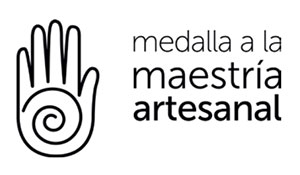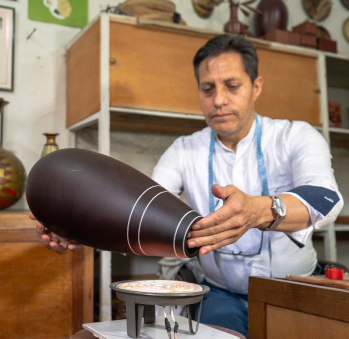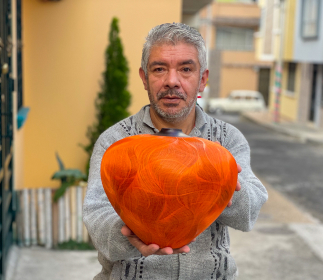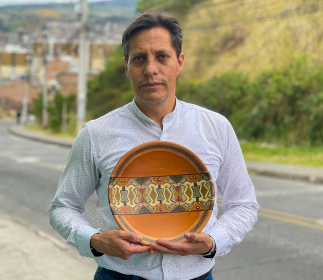Germán Obando
Germán is the innovator of the Obando lineage. He inherited his family’s tradition, which has preserved the Pasto varnish technique since the mid-nineteenth century. He has practiced the trade for almost 40 years. He believes, however, that his experience goes back another 5 years at least, since, when he was barely 10, he started working as an apprentice in the workshop of his father, José María Obando. He would sit next to him and watch him work rigorously. Both he and his sister, Nancy, learned to be disciplined through example.
He likes to tell the long history of one of the techniques the Spaniards brought to the Americas in colonial times. He recounts how the images that were drawn with said technique initially depicted windmills, swan lakes, and castles. These portrayals ultimately evolved and adapted to their new home: they started representing its peculiarities and the charm of syncretism. Germán also mentions how brutal the country’s battles for independence were and how entire communities of craftspeople were decimated by the war. His family, fortunately, survived this turmoil.
The passage of time has left its mark in the long history of varnish. The latter has been home to everything from Cervantes’s mills and castles, to Nariño’s mountains, peasants, ñapangas, and virgins; as well as the land’s pre-Hispanic past. These craftspeople portrayed San Agustín’s “mummies”, as they called them, and explored in-depth the iconography of the Pasto and Tumaco people, the region’s long-time neighbors and inhabitants.
Germán has even delved into Tayrona and Zenú graphical patterns. He finds their designs to be extremely rich and adds the fauna and flora that accompany them. The fineness of his strokes and the search for extremely delicate gestures in the figures he crafts are trademarks of his. He is an insatiable researcher and is convinced that the best way to preserve tradition is, paradoxically, through innovation. He has been awarded the Medalla a la Maestría Artesanal Contemporánea (Contemporary Crafts Mastery Medal). Moreover, his quest to find new ways to use the Pasto varnish technique has been unstoppable.
For instance, whenever he made ñapangas, he dressed them in beautifully decorated suits and skirts as if he were a fashion designer. This path eventually allowed him to tailor a handcrafted outfit for a Miss Nariño to participate in the Miss Colombia National Beauty Pageant, as well as to design a collection of footwear for several fashion shows. In addition, Germán and his brother, who is an industrial designer, created a “Galeras vase” inspired by Pasto’s iconic volcano. They also fashioned a line of products for drinking coffee, which earned them the Lápiz de Acero (Steel Pencil) design award on two occasions.
Germán’s innovative drive has led to multiple collaborations between artists. One of said joint ventures happened with jeweler Tatiana Apráez, who replaced certain precious stone applications in her accessories with Pasto varnish. Another one took place with designer Francesca Miranda, who designed a sophisticated collection of handbags using the technique in question. Germán is up for almost anything: be it veneering refrigerator doors, designing vintage-whiskey-bottle packaging, or applying varnish on glass, metal, marble, or cork. Obando is taking Nariño’s original product to a whole new level.
Craft


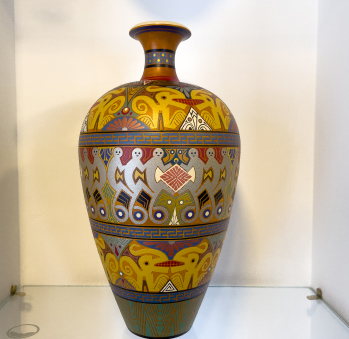



Artisans along the way
Artisans along the way
No puede copiar contenido de esta página








































